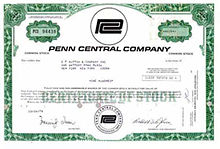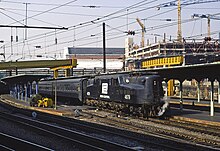Penn Central Transportation
The Penn Central Transportation (PCTC), in short: Penn Central (PC) was an American railroad company , based in Philadelphia . It was created on 1 February 1968 from the merger of the two arch-rival New York Central (NYC) and Pennsylvania Railroad (PRR) and went on 21 June 1970 in bankruptcy . It was the sixth largest American company and generated the largest bankruptcy in history. Penn Central had a network of around 32,000 kilometers in length. The route network reached the states of Illinois ( Peoria , St. Louis , Chicago ), Indiana , Michigan , Ohio , Pennsylvania , Maryland , Delaware , New York , New Jersey , New Hampshire , Rhode Island and Massachusetts and Montréal in Canada.
history
On May 8, 1962, the shareholders of New York Central (NYC) and the Pennsylvania Railroad (PRR) agreed to merge the two companies. The Interstate Commerce Commission approved the merger with various conditions. So the bankrupt or threatened with bankruptcy New York, Susquehanna & Western , New York, New Haven and Hartford Railroad and the Lehigh Valley Railroad should be taken over. The latter two companies were taken over on December 31, 1968 and January 1, 1969 by Penn Central, the former managed to remain independent of Penn Central.
The merger
On February 1, 1968, the PRR, founded in 1846, changed its name to Pennsylvania New York Central Transportation Co. and at the same time merged with NYC. On May 8, 1968, the name was changed to Penn Central Company . Shortly before bankruptcy, the Penn Central Company was renamed Penn Central Transportation on October 1, 1969 and became a subsidiary of the newly established holding Penn Central Company . This was intended to continue the diversification into other industries that had already begun at the Pennsylvania Railroad before the merger. At the time of bankruptcy, most of the company's non-rail operations were bundled in the Pennsylvania Company .
The two companies were rivals for decades and the company philosophies were also very different. Since many management positions were filled by PRR employees with the merger, many, above all young, innovative executives from the former NYC left the company. In addition to these internal structural problems, there was the decline of the steel industry in the north-east of the USA, the growing competitive pressure from truck traffic and the strong regulations of the entire railway system. In addition, the company now had large excess capacities, especially in terms of infrastructure. On the one hand, there were four- and six-track lines where a double-track line was sufficient, and on the other hand, both earlier companies covered almost the same area west of the Allegheny Mountains .
Before the merger, both companies were in the black. In their first year together, the deficit was $ 2.8 million and in 1969 it was $ 83 million. After the loss rose to $ 325.8 million in 1970, the company had to file for bankruptcy on June 21, 1970. Despite the bankruptcy proceedings, the business had to be kept running as there were no alternatives.
As part of the bankruptcy proceedings, it was established in 1974 that the proceedings could not be concluded positively. In order to draw up a rescue plan for Penn Central, the state-owned United States Railway Association (USRA) was formed on the basis of the Regional Rail Reorganization Act of 1973 and the Consolidated Rail Corporation ( Conrail ) was founded, which manages the operations and business assets of Penn Central and some other companies took over from April 1, 1976.
After 1976
After the business assets were transferred to Conrail, the insolvency administrators were able to draw up a restructuring plan. With the completion of the bankruptcy proceedings on October 24, 1978, the parent company Penn Central was merged with Penn Central Transportation. The newly created company was renamed Penn Central Corporation. Renamed American Premier Underwriters in 1994, the company merged to become American Financial Group the following year .
passenger traffic
Due to the high market share in the Northeast Corridor Washington – Philadelphia – New York – Boston, the company endeavored to continue to offer high-quality passenger train services there. New trains were tested together with the US Department of Transportation. This was on the one hand the introduction of the 176 km / h electric multiple units " Metroliner " between New York and Washington and on the other hand the United Aircraft TurboTrains on the Boston – New York route . The latter, however, did not work.
From May 1, 1971, long-distance passenger transport was taken over by the Amtrak . The local transport services were continued by PC and only taken over by them when the Conrail was founded. The local transport authorities ( MARC , Metro-North , MBTA , SEPTA and NJ Transit ) took over Conrail's local rail passenger transport from 1983.
Corporate management
- February 1, 1968-30. November 1969: Alfred E. Perlman (Chairman, President, Chief Executive Officer)
- December 1, 1969 - August 11, 1970: Paul A. Gorman (Chairman, President, Chief Executive Officer)
- September 1, 1970 - January 4, 1974: William H. Moore (President)
- Jan. 11, 1974 - April 1, 1976: Jervis Langdon Jr.
- Trustees (liquidators)
- July 22, 1970–11. January 1974: Jervis Langdon Jr.
- Jan. 11, 1974-24. October 1978: Robert W. Blanchette
- July 22, 1970-28. December 1972: W. Willard Wirtz
- July 22, 1970-18. June 1974: George Pierce Baker
- June 18, 1974-24. October 1978: John H. McArthur
- July 22, 1970-24. October 1978: Richard C. Bond
See also
literature
- Joseph R. Daughen: The Wreck of the Penn Central . Beard Books, 1971, ISBN 978-1-893122-08-6 (English).
- Rush Loving, Jr .: The Men Who Loved Trains: The Story of Men Who Battled Greed to Save an Ailing Industry . Indiana University Press, 2006, ISBN 978-0-253-34757-2 (English).



